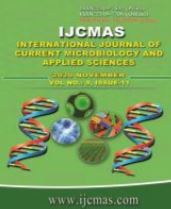


 National Academy of Agricultural Sciences (NAAS)
National Academy of Agricultural Sciences (NAAS)

|
PRINT ISSN : 2319-7692
Online ISSN : 2319-7706 Issues : 12 per year Publisher : Excellent Publishers Email : editorijcmas@gmail.com / submit@ijcmas.com Editor-in-chief: Dr.M.Prakash Index Copernicus ICV 2018: 95.39 NAAS RATING 2020: 5.38 |
Field experiment was conducted at research farm Bihar agricultural university, Sabour during Kharif -2019 to find the appropriate row ratio of cereal and legume intercrop for better quality of forage with maximum net returns. Intercropping system had significant effect on nutritive value of forage crops and economics. The experiment was laid out in randomized block design consisting of 11 treatments e. i. sole sorghum, sole pearl millet, sole cowpea, sorghum + cowpea and pearl millet + cowpea intercropping each with 1:1, 1:2, 2:1, 2:2 row ratio with three replications. Among the different row ratios of intercropping, the green fodder and dry fodder yield as 491.0 and 103.30 q ha-1 respectively were found significantly higher with 2:1 row ratio intercropping of sorghum and cowpea. Quality parameters of cereal fodder were influenced by intercropping of cowpea because it is able to fix the atmospheric N, some part of which might have become available to cereal crop. In aspect of quality parameter the average crude protein (18.16 %) and ash content (15.89 %) were found significantly higher with minimum average crude fiber content (23.42 %) in sole cowpea followed by 1:2 row ratio intercropping of pearl millet + cowpea and sorghum + cowpea. Whereas, crude protein yield (5.52 q ha-1) was found significantly higher with 2:1 row ratio intercropping of sorghum and cowpea due to its greater biomass production followed by 1:1 and 2:2 row ratio of sorghum and cowpea. The Highest gross return (79,731 Rs ha-1), net returns (55,597 Rs ha-1) and B: C ratio (2.30) was obtained under 2:1 row ratio intercropping of sorghum and cowpea which is significantly higher than all other treatments. Therefore it is concluded that, intercropping of sorghum and cowpea with 2:1 row ratio is found economically viable for farmers with quality green fodder and higher net returns.
 |
 |
 |
 |
 |